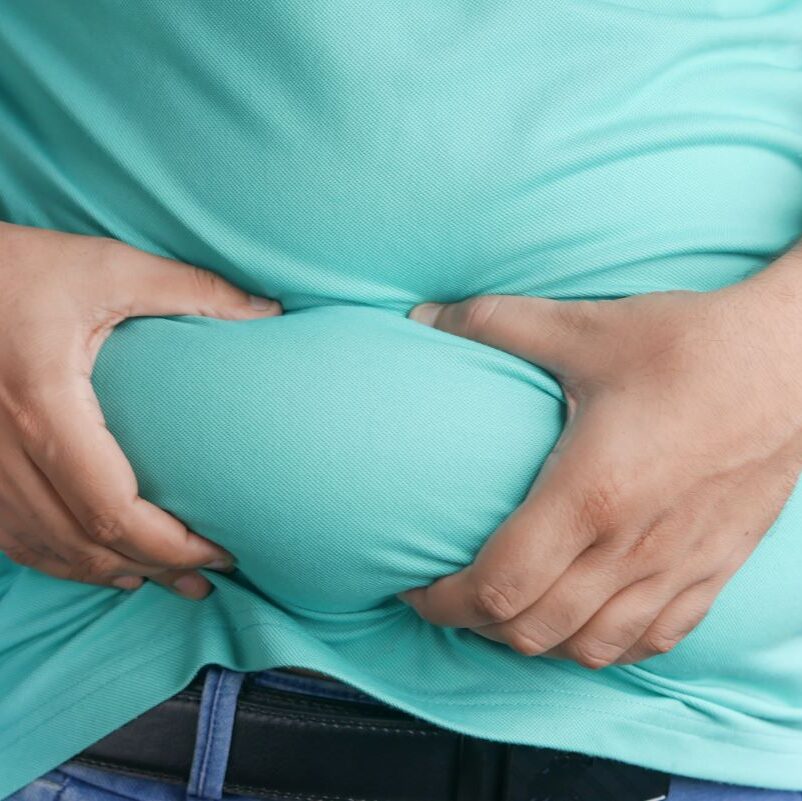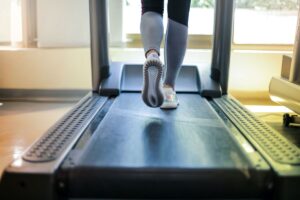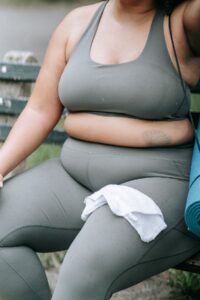
It’s bad enough to struggle with weight gain and body fat after 50. But having belly fat to the point of pants getting too tight to fasten or rolls that could be likened to Santa Claus’ “bowl fully of jelly” is quite enough.
I’ve had it with fat around the midsection, and it’s finally time I’m doing something about it!
My husband I have similar body types, aptly described as “apples.” That means weight seems to concentrate on the middle, while hips, buttocks, and extremities like arms and legs remain pretty much unaffected.
That’s not to say that “pear shapes” don’t also gain belly fat as well, but extra pounds typically migrate to other areas more.
Of course, no matter your body shape or age, excess weight is never healthy. Can we all say, “ugh!”
After turning 60, I noticed that weight was sticking around more than it had in previous decades. Since the timing coinciding with the pandemic, I was quick to point to the fact that pretty much everyone (so it seems) suffered from “Covid weight.” However, the reality has since settled in.
If it was attributable to the fact that everyone seemed to be remaining indoors for a while and exercise habits went out the window, what’s the excuse for today when a sense of normalcy has mostly returned?
So, here we are. I have excess belly fat. And I finally have plans to do something about it.
Why Is Belly Fat So Bad?
Belly fat, especially among individuals over the age of 50, can have a significant impact on overall health and well-being.
As people age, their metabolism tends to slow down, leading to easier weight gain and accumulation of fat around the midsection.
This excess belly fat not only affects one’s physical appearance but also poses a higher risk for various health conditions such as heart disease, type 2 diabetes (which I have), and certain types of cancer.
In addition to its aesthetic concerns, belly fat in individuals over the age of 50 can also have detrimental effects on a person’s mobility and quality of life. Excess abdominal fat puts increased pressure on the organs in that area, including the stomach and intestines.
This pressure can contribute to digestive issues such as acid reflux or indigestion.
Furthermore, carrying excess weight around the midsection may lead to decreased flexibility and agility, making it harder for individuals to engage in physical activities they once enjoyed.
To combat belly fat after the age of 50, it is essential to adopt a healthy lifestyle that includes regular exercise and a balanced diet rich in fruits, vegetables, lean proteins, whole grains, and healthy fats.
 Engaging in aerobic exercises like walking or cycling can help burn calories while strength training exercises can help build muscle mass which boosts metabolism.
Engaging in aerobic exercises like walking or cycling can help burn calories while strength training exercises can help build muscle mass which boosts metabolism.
Additionally, reducing stress levels through practices like meditation or yoga may also aid in managing weight gain associated with hormonal changes during this stage of life.
Circling back to the apple body shape also puts the increased risk of negative health in perspective.
Numerous studies show that apple shapes are worst for wear than pear shapes (although you pears shouldn’t go out and celebrate quite yet).
Various studies show that people with belly fat are more likely to have heart disease and type 2 diabetes. And that is regardless of body mass index (better known as BMI).
Studies also support that the dreaded belly fat can also lead to poorer blood flow in the body and increased risk of certain diseases and cancers.
Research suggests that abdominal obesity is linked to an elevated risk for colon, kidney, breast (in postmenopausal women), and pancreatic cancers. The presence of these additional adipose tissues may promote inflammation and alter hormone levels within the body – factors that can contribute to the development and progression of cancerous cells. This applies to women and men.
Causes: Factors that Contribute to the Dreaded Belly Fat
- As we age, our metabolism tends to slow down, which can contribute to the accumulation of belly fat.
This is because our bodies naturally start to lose muscle mass and gain more fat as we get older. One significant danger associated with this fat accumulation is an increased likelihood of developing cardiovascular diseases.
The visceral fat that accumulates around the abdomen tends to release fatty acids into the bloodstream, which can lead to high cholesterol levels, elevated blood pressure, and an increased risk of heart attacks or strokes.
- Hormonal changes play a role for both men and women and how fat is stored.
Hormones that occur during menopause for women can lead to an increase in belly fat due to a decrease in estrogen levels, which has been linked to a redistribution of body fat from the hips and thighs to the abdominal area.
For men, hormones also can lead to fat storage in the stomach area.
- Not surprisingly, a person’s height and limb length due to genetics can play a huge role in how our body looks in body shape.
Having a longer torso can affect weight distribution and overall look. That’s why sometimes people are told they “hide” their weight gain better than others.
But, it’s important to note, that cloaking excessive weight in no way means the person is any healthier. (Sad face, as I’m 5’9”.)
- Sedentary lifestyle.
As people age, they may become less active and engage in fewer physical activities or exercise routines.This lack of activity can lead to weight gain and an increase in overall body fat, including in the abdominal region.
And health experts seem to agree that light to moderate physical activity levels are better overall than just losing the weight without any additional lifestyle changes due to more positive metabolic effects.
Specifically targeting belly fat through exercise routines becomes increasingly important. Incorporating both cardiovascular exercises and strength training into your routine is essential.
Cardiovascular activities like walking or swimming can help burn calories and reduce overall body fat, including belly fat.
 In addition to cardio workouts, incorporating strength training exercises can also help tone and tighten the abdominal muscles while burning calories.
In addition to cardio workouts, incorporating strength training exercises can also help tone and tighten the abdominal muscles while burning calories.Exercises that specifically target the core muscles and can aid in reducing belly fat. It’s crucial to maintain proper form throughout these exercises to avoid injury and maximize results.
Additionally, consider adding in resistance training using weights or resistance bands to build lean muscle mass which can boost your metabolism even further.
Of course, all these workouts need to be adapted to your age and abilities. As with any medical lifestyle change, discuss your weight goals and exercise plans with your physician before getting started.
- Poor dietary choices.
Food can also play a significant role in the accumulation of belly fat among those over 50 years old. Consuming excessive amounts of processed foods high in added sugars and unhealthy fats can contribute to weight gain and abdominal obesity. These types of foods are often low in nutrients but high in calories, leading to an energy imbalance that promotes the storage of excess belly fat.
These types of foods are often low in nutrients but high in calories, leading to an energy imbalance that promotes the storage of excess belly fat.Since exercise alone may not be enough to eliminate belly fat, a well-rounded approach that includes a balanced diet is key. One of the most important steps is adopting a healthy and balanced diet. This means increasing the consumption of fruits, vegetables, whole grains, lean proteins, and healthy fats while reducing the intake of processed foods, sugary beverages, and saturated fats.
As part of diet choices, ensure you consume enough fiber-rich foods. Fiber aids digestion and helps keep you feeling full for longer periods, which can prevent overeating and promote weight loss. Consider adding sources of soluble fiber like legumes, oats, flaxseeds, and Brussels sprouts to your meals.
Additionally, it’s crucial to pay attention to portion sizes when trying to lose belly fat at an older age.
Reduce large portion sizes or try eating smaller meals more frequently throughout the day to help control hunger levels and maintain stable blood sugar levels.
- Alcohol can be a problem when trying to lose belly fat, regardless of the “type” of alcohol consumed. The key is to limit it overall.
 Alcohol can impact sleep habits and contribute to sleep apnea.
Alcohol can impact sleep habits and contribute to sleep apnea.People often say they are having a glass of two of wine to help them sleep, when the medical experts say the opposite actually is true, as the quality of sleep can be impacted.
Combatting Belly Fat: Stress-Less Strategy to Improve Your Health
As individuals age, it becomes increasingly challenging to combat belly fat. Beyond physical exercise and better eating choices is managing stress.
High levels of stress can lead to weight gain around the waistline due to increased cortisol production. Practicing relaxation techniques such as yoga or meditation can also aid in reducing excess belly fat.
It sounds like it will require effort to take control of your health and waistline, because it does. But by doing so, you can live your best and healthiest life for longer. I certainly know that a smaller, healthier me will make for a happier me overall.
So, smaller waist and healthier lifestyle … here I come!
Questions or comments?
Written by
Robin McClure
Robin is the author of 7 parenting books and has 3 grown children, 3 spoiled rescue dogs, and a very understanding husband. She holds a bachelor's degree in journalism and a master's degree in communications, and spends her time writing, drinking coffee, and planning the next grand adventure.



